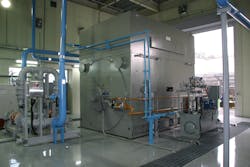The synchronous condenser was once an antiquated relic of the past. Utilities celebrated the removal of the last synchronous condenser from their system. Others who still needed them used them quietly, as if there was disgrace or embarrassment in relying on one. Fast-forward to today and synchronous condensers are now in demand. All the major manufacturers have reported recent sales of new synchronous condensers to support power transmission. Why the resurgence? Read on.
What Is It?
Some people see synchronous condensers as motors without any load connected. Others view them as generators without prime movers. Both are correct. The field is varied, just like it would be on a generator, to produce or absorb reactive power.
Generation Mix
Voltage and frequency regulation was required for stability and to create consumer confidence. People learned they could depend on this power and, over the years, found more uses for electricity, in both work and leisure. Our modern society is dependent on, and one could argue addicted to, electric power.
There are several factors involved in the renewed interest in synchronous condensers, particularly the changing mix of generation, specifically more wind and solar. The optimal locations for renewable power generation are often remote to the load centers where the power is needed. This puts a burden on the transmission system. While FACTS devices such as SVCs and STATCOMs are good at supplying reactive power quickly, they are less helpful with system inertia and short-circuit strength.
As the generation mix evolves to a higher penetration of renewables and less traditional thermal generation, there are places in the power grid where low short-circuit strength and even low system inertia are a concern. Adding synchronous condensers can help with reactive power needs and also increase system inertia and increase short-circuit strength.
Modern Machines with New Technologies
Another reason new synchronous condensers are receiving acceptance is the machine technology. Machines of the past had a very slow speed of response. Analog control systems and rheostats were not able to provide adequate response to dynamic events. When some of these older machines and their controls are retired, those responsible for their maintenance upkeep probably do find cause for celebration. A new machine, however, comes with the latest digital controls and relays, and uses the same digital field exciter as you might find in the most modern combined cycle facility. The speed and precision of modern exciters allows the performance of new synchronous condensers to rival their SVC counterparts.
Machine manufacturing and construction have also advanced over the years. At one time synchronous condensers were commonly made with 10 to 12 poles for a slower speed. The bearings and precise shaft balancing needed to produce a two-pole or four-pole machine were considered special and were very expensive. Now a two-pole synchronous generator is considered standard. Modern insulation systems and manufacturing techniques allow new synchronous condensers to exhibit a high degree of reliability and availability.
Brushes can be a maintenance concern but modern machines can be built as brushless machines. This is achieved through a rotating exciter built onto the shaft. A small digital exciter excites the rotating exciter, which is sometimes referred to as the “inside out machine.” This eliminates one of the more significant maintenance elements.
What to Expect
No one is suggesting that the era of FACTS devices has come to an end. Rather, we have reached an era where power electronic technology is finding uses behind the scenes in other products and is enhancing their performance. While a condenser will not make sense in every case, or even in most cases, there are niche applications where it might. These applications are often island power systems, locations at the edge of a power grid or locations where there is a large HVDC in-feed.
Instead of disregarding synchronous condensers outright, many transmission owners are realizing that with an IGBT-based exciter and modern digital controls, they can be a helpful item. Instead of viewing them as undesirable, perhaps they should be considered the premium reactive power device; they cost more, but you get something more. Where rate of change of frequency is a concern, or where there is very low short-circuit strength, a synchronous condenser can be very helpful. Some people would call them a necessary evil. Are they really evil? Perhaps not.
